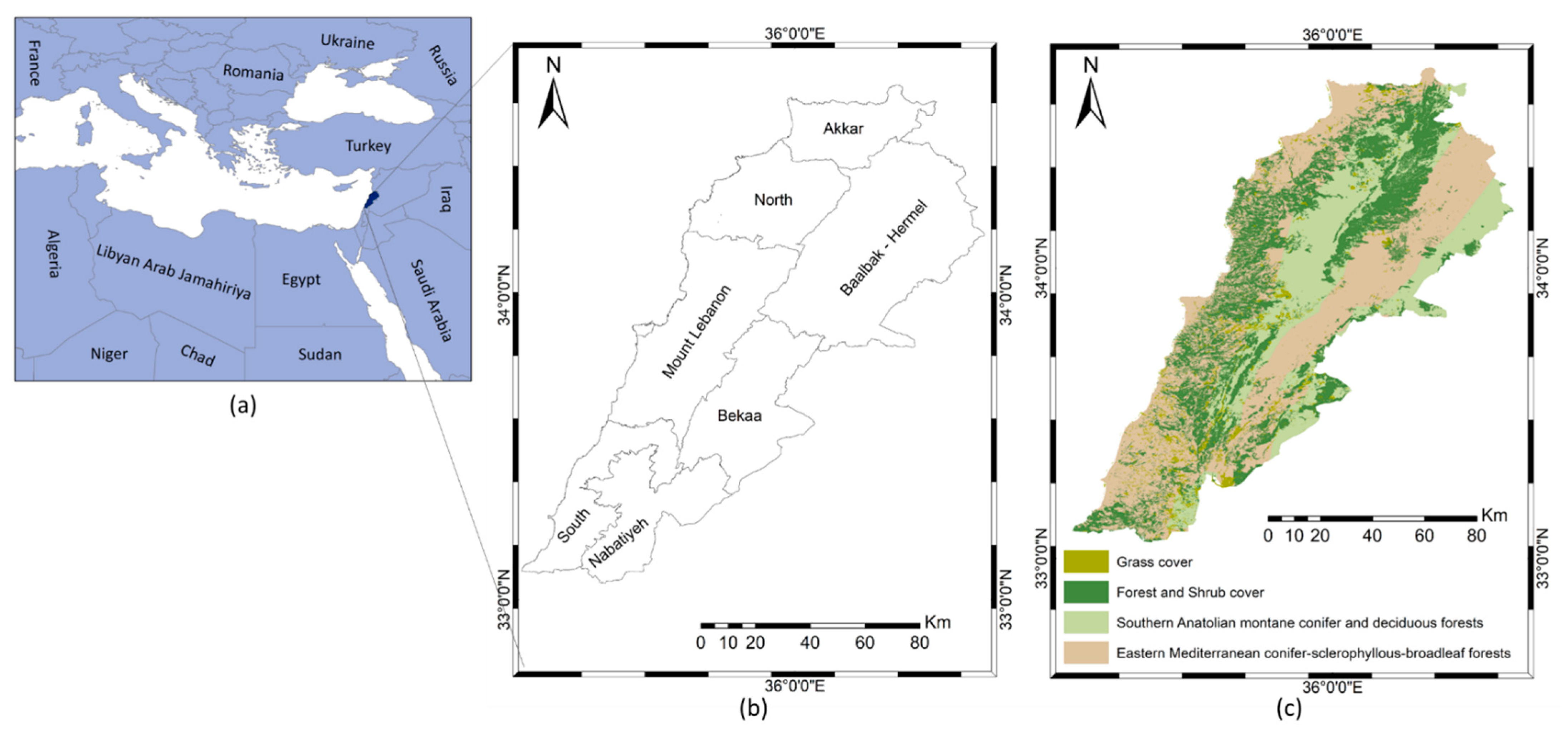Fire Regime Analysis in Lebanon (2001–2020): Combining Remote Sensing Data in a Scarcely Documented Area
Abstract
:1. Introduction
2. Materials and Methods
2.1. Study Area
2.2. Data
2.2.1. Active Fire Data: NASA FIRMS
2.2.2. Burnt Area Data
- ESA FireCCI51: this database is developed as part of the ESA Climate Change Initiative (CCI) Program. FireCCI51 is a monthly global BA product available for 2001–2019 with a spatial resolution of 250 m based on MODIS red and near-infrared reflectance and thermal anomaly data (full description of the product is found in [29,30]). The data was downloaded from https://climate.esa.int/en/projects/fire/data/ (accessed on 1 July 2021);
- MCD64A1: This monthly global BA product is available from November 2000 to present with a spatial resolution of 500 m based on MODIS data (Terra and Aqua). This new version has a refined algorithm, allowing it to capture smaller fires compared to older versions (e.g., MCD45A1) (full description of the product is found in [28]). The data was downloaded from https://modis-land.gsfc.nasa.gov/burn.html (accessed on 1 July 2021);
- National fire inventory: The available national fire records were provided by the National Center for Remote Sensing of the CNRS-L (National Council for Scientific Research, Beirut, Lebanon). Fire information was gathered from many sources: the Al-Nahar newspaper (1983–2003), Lebanese Civil Defense (2002 and 2003), the Ministry of Environment (1994–1998), the Ministry of Agriculture (1996–2002), and Beirut fire stations (1998). These fire records (in paper form) were treated and provided by the CNRS-L as Excel tables describing the location, date, and type of vegetation burnt (database described in [19]);
- The University of Balamand and the Ministry of Environment technical fire reports: Yearly fire technical reports are produced, since 2008, through collaborative work between the Institute of the Environment at the University of Balamand (UOB) and the Ministry of Environment (MoE) within the USAID-PEER project. They provide monthly BA extent and numbers based on fire ID cards filled by the Internal Security Forces and copied to the Ministry of Environment (adapted from http://ioe-firelab.balamand.edu.lb/pages/ProfileCountryAnnex5.aspx, accessed on 1 July 2021).
2.2.3. Landsat Data Processing
2.2.4. Climatic Data
2.2.5. Statistical Analysis
3. Results
3.1. Burnt Area in Lebanon: General Information
3.2. Data Quality Checking
3.3. Annual Burnt Area and Fire Number
3.4. Fire Seasonality
3.5. Fire Weather
4. Discussion
4.1. Data Quality Assessment
4.2. A Unique Bimodal Fire Seasonality in the Mediterranean Basin
4.3. Interannual Burnt Area and Trends
5. Conclusions
Author Contributions
Funding
Data Availability Statement
Acknowledgments
Conflicts of Interest
References and Note
- Paula, S.; Arianoutsou, M.; Kazanis, D.; Tavsanoglu, Ç.; Lloret, F.; Buhk, C.; Ojeda, F.; Luna, B.; Moreno, J.M.; Rodrigo, A. Fire-Related Traits for Plant Species of the Mediterranean Basin. Ecology 2009, 90, 1420. [Google Scholar] [CrossRef]
- Dimitrakopoulos, A.P.; Mitsopoulos, I.D. Global Forest Resources Assessment 2005—Report on Fires in the Mediterranean Region; Fire Management Working Papers; FAO: Rome, Italy, 2006; p. 38. [Google Scholar]
- Le Houérou, H.N. Fire and Vegetation in the Mediterranean Basin; FAO: Rome, Italy, 1973. [Google Scholar]
- Clark, J.S.; Grimm, E.C.; Donovan, J.J.; Fritz, S.C.; Engstrom, D.R.; Almendinger, J.E. Drought Cycles and Landscape Responses to Past Aridity on Prairies of the Northern Great Plains, USA. Ecology 2002, 83, 595–601. [Google Scholar] [CrossRef]
- Pellizzaro, G.; Cesaraccio, C.; Duce, P.; Ventura, A.; Zara, P. Relationships between Seasonal Patterns of Live Fuel Moisture and Meteorological Drought Indices for Mediterranean Shrubland Species. Int. J. Wildland Fire 2007, 16, 232–241. [Google Scholar] [CrossRef]
- Alexandrian, D.; Esnault, F.; Calabri, G. Forest Fires in the Mediterranean Area. Unasylva 2000, 50, 35–41. [Google Scholar]
- Gill, A.M.; Stephens, S.L.; Cary, G.J. The Worldwide “Wildfire” Problem. Ecol. Appl. 2013, 23, 438–454. [Google Scholar] [CrossRef]
- Pausas, J.G. Changes in Fire and Climate in the Eastern Iberian Peninsula (Mediterranean Basin). Clim. Chang. 2004, 63, 337–350. [Google Scholar] [CrossRef]
- Xanthopoulos, G.; Nikolov, N. Wildfires and Fire Management in the Eastern Mediterranean, Southeastern Europe, and Middle East Regions. Fire Manag. Today 2019, 77, 29–38. [Google Scholar]
- Ruffault, J.; Mouillot, F. How a New Fire-Suppression Policy Can Abruptly Reshape the Fire-Weather Relationship. Ecosphere 2015, 6, art199. [Google Scholar] [CrossRef]
- San-Miguel-Ayanz, J.; Schulte, E.; Schmuck, G.; Camia, A.; Strobl, P.; Liberta, G.; Giovando, C.; Boca, R.; Sedano, F.; Kempeneers, P. Comprehensive Monitoring of Wildfires in Europe: The European Forest Fire Information System (EFFIS). In Approaches to Managing Disaster Assessing Hazards, Emergencies and Disaster Impacts; Intech Open: London, UK, 2012; p. 176. ISBN 978-953-51-0294-6. [Google Scholar]
- Gill, A.M. Fire and the Australian Flora: A Review. Aust. For. 1975, 38, 4–25. [Google Scholar] [CrossRef]
- Belhadj-Khedher, C.; Koutsias, N.; Karamitsou, A.; EI-Melki, T.; Ouelhazi, B.; Hamdi, A.; Nouri, H.; Mouillot, F. A Revised Historical Fire Regime Analysis in Tunisia (1985–2010) from a Critical Analysis of the National Fire Database and Remote Sensing. Forests 2018, 9, 59. [Google Scholar] [CrossRef]
- Chergui, B.; Fahd, S.; Santos, X.; Pausas, J.G. Socioeconomic Factors Drive Fire-Regime Variability in the Mediterranean Basin. Ecosystems 2018, 21, 619–628. [Google Scholar] [CrossRef]
- Aini, A.; Curt, T.; Bekdouche, F. Modelling Fire Hazard in the Southern Mediterranean Fire Rim (Bejaia Region, Northern Algeria). Environ. Monit. Assess. 2019, 191, 747. [Google Scholar] [CrossRef] [PubMed]
- Ruffault, J.; Curt, T.; Moron, V.; Trigo, R.M.; Mouillot, F.; Koutsias, N.; Pimont, F.; Martin-StPaul, N.; Barbero, R.; Dupuy, J.-L. Increased Likelihood of Heat-Induced Large Wildfires in the Mediterranean Basin. Sci. Rep. 2020, 10, 13790. [Google Scholar] [CrossRef]
- Belhadj-Khedher, C.; El-Melki, T.; Mouillot, F. Saharan Hot and Dry Sirocco Winds Drive Extreme Fire Events in Mediterranean Tunisia (North Africa). Atmosphere 2020, 11, 590. [Google Scholar] [CrossRef]
- Faour, G. Forest Fire Fighting in Lebanon Using Remote Sensing and GIS. 2004. Available online: https://www.researchgate.net/publication/310796768_FOREST_FIRE_FIGHTING_IN_LEBANON_USING_REMOTE_SENSING_AND_GIS (accessed on 1 July 2021).
- Faour, G.; Kheir, R.; Verdeil, E. Caractérisation Sous Système d’information Géographique Des Incendies de Forêts: L’exemple Du Liban. For. Méditerr. 2006, 27, 339–352. [Google Scholar]
- Giordano, G. The Mediterranean Region. In A World Geography of Forest Resources; Ronald Press Company: New York, NY, USA, 1956; pp. 317–552. [Google Scholar]
- Faour, G. Evaluating Urban Expansion Using Remotely-Sensed Data in Lebanon. Leban. Sci. J. 2015, 16, 23. [Google Scholar]
- Barrett, P.; Appendino, M.; Nguyen, K.; de Leon Miranda, J. Measuring Social Unrest Using Media Reports. J. Dev. Econ. 2020, 158, 102924. [Google Scholar] [CrossRef]
- Masri, T.; Khawlie, M.; Faour, G.; Awad, M. Mapping Forest Fire Prone Areas in Lebanon. In Proceedings of the EARSeL 23rd Symposium of “Remote Sensing in Transition–4th International Workshop on Remote Sensing and GIS Applications to Forest Fire Management, Ghent, Belgium, 5–7 June 2003; pp. 109–113. [Google Scholar]
- Mhawej, M.; Faour, G.; Abdallah, C.; Adjizian-Gerard, J. Towards an Establishment of a Wildfire Risk System in a Mediterranean Country. Ecol. Inform. 2016, 32, 167–184. [Google Scholar] [CrossRef]
- Mitri, G.; Jazi, M.; McWethy, D. Investigating Temporal and Spatial Variability of Wildfire Potential with the Use of Objectbased Image Analysis of Downscaled Global Climate Models. South-East. Eur. J. Earth Observ. Geomat. 2014, 3, 251–254. [Google Scholar]
- Mitri, G.; Jazi, M.; McWethy, D. Assessment of Wildfire Risk in Lebanon Using Geographic Object-Based Image Analysis. Photogramm. Eng. Remote Sens. 2015, 81, 499–506. [Google Scholar] [CrossRef]
- Giglio, L.; Schroeder, W.; Hall, J.V. MODIS Collection 6 Active Fire Product User’s Guide Revision B; Department of Geographical Sciences, University of Maryland: College Park, MD, USA, 2018; p. 64. [Google Scholar]
- Giglio, L.; Boschetti, L.; Roy, D.P.; Humber, M.L.; Justice, C.O. The Collection 6 MODIS Burned Area Mapping Algorithm and Product. Remote Sens. Environ. 2018, 217, 72–85. [Google Scholar] [CrossRef] [PubMed]
- Chuvieco, E.; Mouillot, F.; van der Werf, G.R.; San Miguel, J.; Tanase, M.; Koutsias, N.; García, M.; Yebra, M.; Padilla, M.; Gitas, I.; et al. Historical Background and Current Developments for Mapping Burned Area from Satellite Earth Observation. Remote Sens. Environ. 2019, 225, 45–64. [Google Scholar] [CrossRef]
- Silva, J.M.; Moreno, M.V.; Le Page, Y.; Oom, D.; Bistinas, I.; Pereira, J.M.C. Spatiotemporal Trends of Area Burnt in the Iberian Peninsula, 1975–2013. Reg. Environ. Chang. 2019, 19, 515–527. [Google Scholar] [CrossRef]
- Fornacca, D.; Ren, G.; Xiao, W. Performance of Three MODIS Fire Products (MCD45A1, MCD64A1, MCD14ML), and ESA Fire_CCI in a Mountainous Area of Northwest Yunnan, China, Characterized by Frequent Small Fires. Remote Sens. 2017, 9, 1131. [Google Scholar] [CrossRef]
- Roteta, E.; Bastarrika, A.; Padilla, M.; Storm, T.; Chuvieco, E. Development of a Sentinel-2 Burned Area Algorithm: Generation of a Small Fire Database for Sub-Saharan Africa. Remote Sens. Environ. 2019, 222, 1–17. [Google Scholar] [CrossRef]
- Nogueira, J.M.; Ruffault, J.; Chuvieco, E.; Mouillot, F. Can We Go beyond Burned Area in the Assessment of Global Remote Sensing Products with Fire Patch Metrics? Remote Sens. 2017, 9, 7. [Google Scholar] [CrossRef]
- Giglio, L.; Loboda, T.; Roy, D.P.; Quayle, B.; Justice, C.O. An Active-Fire Based Burned Area Mapping Algorithm for the MODIS Sensor. Remote Sens. Environ. 2009, 113, 408–420. [Google Scholar] [CrossRef]
- Anaya, J.A.; Chuvieco, E. Accuracy Assessment of Burned Area Products in the Orinoco Basin. Photogramm. Eng. Remote Sens. 2012, 78, 53–60. [Google Scholar] [CrossRef]
- Hawbaker, T.J.; Vanderhoof, M.K.; Beal, Y.-J.; Takacs, J.D.; Schmidt, G.L.; Falgout, J.T.; Williams, B.; Fairaux, N.M.; Caldwell, M.K.; Picotte, J.J. Mapping Burned Areas Using Dense Time-Series of Landsat Data. Remote Sens. Environ. 2017, 198, 504–522. [Google Scholar] [CrossRef]
- Padilla, M.; Stehman, S.V.; Chuvieco, E. Validation of the 2008 MODIS-MCD45 Global Burned Area Product Using Stratified Random Sampling. Remote Sens. Environ. 2014, 144, 187–196. [Google Scholar] [CrossRef]
- Franquesa, M.; Vanderhoof, M.K.; Stavrakoudis, D.; Gitas, I.Z.; Roteta, E.; Padilla, M.; Chuvieco, E. Development of a Standard Database of Reference Sites for Validating Global Burned Area Products. Earth Syst. Sci. Data 2020, 12, 3229–3246. [Google Scholar] [CrossRef]
- Benali, A.; Russo, A.; Sá, A.C.; Pinto, R.; Price, O.; Koutsias, N.; Pereira, J. Determining Fire Dates and Locating Ignition Points with Satellite Data. Remote Sens. 2016, 8, 326. [Google Scholar] [CrossRef]
- Chuvieco, E.; Englefield, P.; Trishchenko, A.P.; Luo, Y. Generation of Long Time Series of Burn Area Maps of the Boreal Forest from NOAA–AVHRR Composite Data. Remote Sens. Environ. 2008, 112, 2381–2396. [Google Scholar] [CrossRef]
- Çolak, E.; Sunar, F. The Importance of Ground-Truth and Crowdsourcing Data for the Statistical and Spatial Analyses of the NASA FIRMS Active Fires in the Mediterranean Turkish Forests. Remote Sens. Appl. Soc. Environ. 2020, 19, 100327. [Google Scholar] [CrossRef]
- Harrison, S.P.; Marlon, J.R.; Bartlein, P.J. Fire in the Earth System. In Changing Climates, Earth Systems and Society; Springer: Berlin/Heidelberg, Germany, 2010; pp. 21–48. [Google Scholar]
- Sá, A.C.; Benali, A.; Fernandes, P.M.; Pinto, R.M.; Trigo, R.M.; Salis, M.; Russo, A.; Jerez, S.; Soares, P.M.; Schroeder, W. Evaluating Fire Growth Simulations Using Satellite Active Fire Data. Remote Sens. Environ. 2017, 190, 302–317. [Google Scholar] [CrossRef] [Green Version]
- Köppen, W. Die Wärmezonen Der Erde, Nach Der Dauer Der Heissen, Gemässigten Und Kalten Zeit Und Nach Der Wirkung Der Wärme Auf Die Organische Welt Betrachtet. Meteorol. Z. 1884, 1, 5–226. [Google Scholar]
- Medail, F.; Quezel, P. Hot-Spots Analysis for Conservation of Plant Biodiversity in the Mediterranean Basin. Ann. Mo. Bot. Gard. 1997, 84, 112–127. [Google Scholar] [CrossRef]
- Zohary, M. Geobotanical Foundations of the Middle East; Fischer: Ried im Innkreis, Austria, 1973; ISBN 90-265-0157-9. [Google Scholar]
- Olson, D.M.; Dinerstein, E.; Wikramanayake, E.D.; Burgess, N.D.; Powell, G.V.N.; Underwood, E.C.; D’Amico, J.A.; Itoua, I.; Strand, H.E.; Morrison, J.C.; et al. Terrestrial Ecoregions of the World: A New Map of Life on Earth. Bioscience 2001, 51, 933–938. [Google Scholar] [CrossRef]
- CNRS-L 2017 Land Cover/Land Use Map of Lebanon Scale 1/20000 2019
- Ellair, D.P.; Platt, W.J. Fuel Composition Influences Fire Characteristics and Understorey Hardwoods in Pine Savanna. J. Ecol. 2013, 101, 192–201. [Google Scholar] [CrossRef]
- Williamson, G.B.; Black, E.M. High Temperature of Forest Fires under Pines as a Selective Advantage over Oaks. Nature 1981, 293, 643–644. [Google Scholar] [CrossRef]
- MOE. Lebanon Country Report on Biodiversity; MOE: Singapore, 2016. [Google Scholar]
- Giglio, L.; Van der Werf, G.R.; Randerson, J.T.; Collatz, G.J.; Kasibhatla, P. Global Estimation of Burned Area Using MODIS Active Fire Observations. Atmos. Chem. Phys. 2006, 6, 957–974. [Google Scholar] [CrossRef]
- Giglio, L.; Randerson, J.T.; Van der Werf, G.R.; Kasibhatla, P.S.; Collatz, G.J.; Morton, D.C.; DeFries, R.S. Assessing Variability and Long-Term Trends in Burned Area by Merging Multiple Satellite Fire Products. Biogeosciences 2010, 7, 1171–1186. [Google Scholar] [CrossRef]
- Pinto, M.M.; Trigo, R.M.; Trigo, I.F.; DaCamara, C.C. A Practical Method for High-Resolution Burned Area Monitoring Using Sentinel-2 and VIIRS. Remote Sens. 2021, 13, 1608. [Google Scholar] [CrossRef]
- Giglio, L.; Schroeder, W.; Justice, C.O. The Collection 6 MODIS Active Fire Detection Algorithm and Fire Products. Remote Sens. Environ. 2016, 178, 31–41. [Google Scholar] [CrossRef] [PubMed]
- Schroeder, W.; Oliva, P.; Giglio, L.; Csiszar, I.A. The New VIIRS 375 m Active Fire Detection Data Product: Algorithm Description and Initial Assessment. Remote Sens. Environ. 2014, 143, 85–96. [Google Scholar] [CrossRef]
- Bastarrika, A.; Alvarado, M.; Artano, K.; Martinez, M.P.; Mesanza, A.; Torre, L.; Ramo, R.; Chuvieco, E. BAMS: A Tool for Supervised Burned Area Mapping Using Landsat Data. Remote Sens. 2014, 6, 12360–12380. [Google Scholar] [CrossRef] [Green Version]
- Rouse, J.W.; Haas, R.H.; Schell, J.A.; Deering, D.W.; Harlan, J.C. Monitoring the Vernal Advancement and Retrogradation (Green Wave Effect) of Natural Vegetation; Texas A&M University Remote Sensing Center: College Station, TX, USA, 1973. [Google Scholar]
- Key, C.H.; Benson, N.C. The Normalized Burn Ratio (NBR): A Landsat TM Radiometric Measure of Burn Severity; United States Geological Survey, Northern Rocky Mountain Science Center: Bozeman, MT, USA, 1999. [Google Scholar]
- Garcia, M.J.L.; Caselles, V. Mapping Burns and Natural Reforestation Using Thematic Mapper Data. Geocarto Int. 1991, 6, 31–37. [Google Scholar] [CrossRef]
- Roteta, E.; Bastarrika, A.; Franquesa, M.; Chuvieco, E. Landsat and Sentinel-2 Based Burned Area Mapping Tools in Google Earth Engine. Remote Sens. 2021, 13, 816. [Google Scholar] [CrossRef]
- Belgiu, M.; Drăguţ, L. Random Forest in Remote Sensing: A Review of Applications and Future Directions. ISPRS J. Photogramm. Remote Sens. 2016, 114, 24–31. [Google Scholar] [CrossRef]
- Koutsias, N.; Pleniou, M. A Rule-Based Semi-Automatic Method to Map Burned Areas in Mediterranean Using Landsat Images—Revisited and Improved. Int. J. Digit. Earth 2021, 14, 1602–1623. [Google Scholar] [CrossRef]
- Muñoz-Sabater, J.; Dutra, E.; Agustí-Panareda, A.; Albergel, C.; Arduini, G.; Balsamo, G.; Boussetta, S.; Choulga, M.; Harrigan, S.; Hersbach, H.; et al. ERA5-Land: A State-of-the-Art Global Reanalysis Dataset for Land Applications. Earth Syst. Sci. Data 2021, 13, 4349–4383. [Google Scholar] [CrossRef]
- Bak, P.; Tang, C.; Wiesenfeld, K. Self-Organized Criticality. Phys. Rev. A 1988, 38, 364. [Google Scholar] [CrossRef] [PubMed]
- Ricotta, C.; Arianoutsou, M.; Dıaz-Delgado, R.; Duguy, B.; Lloret, F.; Maroudi, E.; Mazzoleni, S.; Moreno, J.M.; Rambal, S.; Vallejo, R. Self-Organized Criticality of Wildfires Ecologically Revisited. Ecol. Model. 2001, 141, 307–311. [Google Scholar] [CrossRef]
- Royston, J.P. An Extension of Shapiro and Wilk’s W Test for Normality to Large Samples. J. R. Stat. Soc. Ser. C Appl. Stat. 1982, 31, 115–124. [Google Scholar] [CrossRef]
- Royston, J.P. Algorithm AS 181: The W Test for Normality. J. Appl. Stat. 1982, 44, 176–180. [Google Scholar] [CrossRef]
- Royston, P. Remark AS R94: A Remark on Algorithm AS 181: The W-Test for Normality. J. R. Stat. Soc. Ser. C Appl. Stat. 1995, 44, 547–551. [Google Scholar] [CrossRef]
- Becker, R.A.; Chambers, J.M.; Wilks, A.R. The New S Language; Wadsworth & Brooks/Cole; CRC Press: Belmont, CA, USA, 1988; ISBN 978-1-351-09188-6. [Google Scholar]
- Chambers, J.M.; Cleveland, W.S.; Tukey, P.A.; Kleiner, B. Graphical Methods for Data Analysis, 1st ed.; Chapman and Hall/CRC: New York, NY, USA, 2017; ISBN 978-1-351-07230-4. [Google Scholar]
- Murrell, P. R Graphics; Chapman and Hall/CRC: New York, NY, USA, 2005; ISBN 978-0-429-19610-2. [Google Scholar]
- Sen, P.K. Estimates of the Regression Coefficient Based on Kendall’s Tau. J. Am. Stat. Assoc. 1968, 63, 1379–1389. [Google Scholar] [CrossRef]
- Catarino, S.; Romeiras, M.M.; Figueira, R.; Aubard, V.; Silva, J.; Pereira, J. Spatial and Temporal Trends of Burnt Area in Angola: Implications for Natural Vegetation and Protected Area Management. Diversity 2020, 12, 307. [Google Scholar] [CrossRef]
- Pausas, J.G.; Keeley, J.E. Epicormic Resprouting in Fire-Prone Ecosystems. Trends Plant Sci. 2017, 22, 1008–1015. [Google Scholar] [CrossRef]
- Syphard, A.D.; Keeley, J.E.; Pfaff, A.H.; Ferschweiler, K. Human Presence Diminishes the Importance of Climate in Driving Fire Activity across the United States. Proc. Natl. Acad. Sci. USA 2017, 114, 13750–13755. [Google Scholar] [CrossRef]
- Turco, M.; Bedia, J.; Di Liberto, F.; Fiorucci, P.; Von Hardenberg, J.; Koutsias, N.; Llasat, M.-C.; Xystrakis, F.; Provenzale, A. Decreasing Fires in Mediterranean Europe. PLoS ONE 2016, 11, e0150663. [Google Scholar] [CrossRef] [PubMed]
- Karouni, A.; Daya, B.; Bahlak, S. A Comparative Study to Find the Most Applicable Fire Weather Index for Lebanon Allowing to Predict a Forest Fire. J. Comput. Commun. 2013, 10, 1403–1409. [Google Scholar]
- Salloum, L.; Mitri, G. Assessment of the Temporal Pattern of Fire Activity and Weather Variability in Lebanon. Int. J. Wildland Fire 2014, 23, 503–509. [Google Scholar] [CrossRef]
- Boschetti, L.; Roy, D.P.; Justice, C.O.; Humber, M.L. MODIS–Landsat Fusion for Large Area 30m Burned Area Mapping. Remote Sens. Environ. 2015, 161, 27–42. [Google Scholar] [CrossRef]
- Bradstock, R.A. A Biogeographic Model of Fire Regimes in Australia: Current and Future Implications. Glob. Ecol. Biogeogr. 2010, 19, 145–158. [Google Scholar] [CrossRef]
- Bajocco, S.; Ferrara, C.; Guglietta, D.; Ricotta, C. Easy-to-Interpret Procedure to Analyze Fire Seasonality and the Influence of Land Use in Fire Occurrence: A Case Study in Central Italy. Fire 2020, 3, 46. [Google Scholar] [CrossRef]
- Michetti, M.; Pinar, M. Forest Fires across Italian Regions and Implications for Climate Change: A Panel Data Analysis. Environ. Resour. Econ. 2019, 72, 207–246. [Google Scholar] [CrossRef] [Green Version]
- Salvati, L.; Ranalli, F. ‘Land of Fires’: Urban Growth, Economic Crisis, and Forest Fires in Attica, Greece. Geogr. Res. 2015, 53, 68–80. [Google Scholar] [CrossRef]
- Nojarov, P.; Nikolova, M. Heat Waves and Forest Fires in Bulgaria. Nat. Hazards 2022, 1–21. [Google Scholar] [CrossRef]
- Calheiros, T.; Nunes, J.P.; Pereira, M.G. Recent Evolution of Spatial and Temporal Patterns of Burnt Areas and Fire Weather Risk in the Iberian Peninsula. Agric. For. Meteorol. 2020, 287, 107923. [Google Scholar] [CrossRef]
- Im, U.; Onay, T.; Yeniguin, O.; Anteplioglu, U.; Incecik, S.; Toppu, S.; Kambezidis, H.; Kaskaoutis, D.; Kassomenos, P.; Melas, D. An Overview of Forest Fires and Meteorology in Turkey and Greece. In Proceedings of the 2006 First International Symposium on Environment Identities and Mediterranean Area, Ajaccio, France, 10–13 July 2006; pp. 62–67. [Google Scholar]
- Keeley, J.E.; Safford, H.; Fotheringham, C.J.; Franklin, J.; Moritz, M. The 2007 Southern California Wildfires: Lessons in Complexity. J. For. 2009, 107, 287–296. [Google Scholar] [CrossRef]
- Keeley, J.E.; Fotheringham, C.J. Historic Fire Regime in Southern California Shrublands. Conserv. Biol. 2001, 15, 1536–1548. [Google Scholar] [CrossRef]
- Emery, N.C.; D’Antonio, C.M.; Still, C.J. Fog and Live Fuel Moisture in Coastal California Shrublands. Ecosphere 2018, 9, e02167. [Google Scholar] [CrossRef]
- Amraoui, M.; Liberato, M.L.R.; Calado, T.J.; DaCamara, C.C.; Coelho, L.P.; Trigo, R.M.; Gouveia, C.M. Fire Activity over Mediterranean Europe Based on Information from Meteosat-8. For. Ecol. Manage. 2013, 294, 62–75. [Google Scholar] [CrossRef]
- Pereira, M.G.; Trigo, R.M.; DaCamara, C.C.; Pereira, J.M.C.; Leite, S.M. Synoptic Patterns Associated with Large Summer Forest Fires in Portugal. Agric. For. Meteor 2005, 129, 11–25. [Google Scholar] [CrossRef]
- AUB-IFI Forest Fires in Lebanon: A Recurring Disaster. 2019. Available online: https://www.aub.edu.lb/ifi/Documents/publications/infographics/2019-2020/20191220_october_forest_fires.pdf (accessed on 1 July 2021).
- Mitri, G. Lebanon’s National Forest Fire Management Strategy; AFDC: Beirut, Lebanon, 2009. [Google Scholar]
- Ruffault, J.; Moron, V.; Trigo, R.M.; Curt, T. Daily Synoptic Conditions Associated with Large Fire Occurrence in Mediterranean France: Evidence for a Wind-Driven Fire Regime. Int. J. Climatol. 2017, 37, 524–533. [Google Scholar] [CrossRef]
- D’Andrea, M.; Fiorucci, P.; Gaetani, F.; Negro, D. RISICO: A Decision Support System (DSS) for Dynamic Wildfire Risk Evaluation in Italy. EGU Gen. Assem. 2010, 2010, 11102. [Google Scholar]
- Mitri, G. Advancing Lebanons Fire Danger Forecast; Limassol, Cyprus. 2015. Available online: https://scholarhub.balamand.edu.lb/handle/uob/967 (accessed on 1 July 2021).
- Sahar, O. Les Feux de Forêt en Algérie: Analyse du Risque, Etude des Causes, Evaluation du Dispositif de Défense et des Politiques de Gestion. Ph.D. Thesis, Université de Tizi Ouzou-Mouloud Mammeri, Tizi Ouzou, Algeria, 2014. [Google Scholar]
- Meddour-Sahar, O.; Derridj, A. Bilan des feux de forêts en Algérie: Analyse spatio-temporelle et cartographie du risque (période 1985-2010). Sci. Changements Planétaires/Sécheresse 2012, 23, 133–141. [Google Scholar] [CrossRef]
- San-Miguel-Ayanz, J.; Rodrigues, M.; de Oliveira, S.S.; Pacheco, C.K.; Moreira, F.; Duguy, B.; Camia, A. Land Cover Change and Fire Regime in the European Mediterranean Region. In Post-Fire Management and Restoration of Southern European Forests; Managing Forest Ecosystems; Springer: Dordrecht, The Netherlands, 2012; Volume 24, pp. 21–43. ISBN 978-94-007-2208-8. [Google Scholar]
- Gudmundsson, L.; Seneviratne, S.I. Anthropogenic Climate Change Affects Meteorological Drought Risk in Europe. Environ. Res. Lett. 2016, 11, 044005. [Google Scholar] [CrossRef]
- Moreno, M.V.; Conedera, M.; Chuvieco, E.; Pezzatti, G.B. Fire Regime Changes and Major Driving Forces in Spain from 1968 to 2010. Environ. Sci. Policy 2014, 37, 11–22. [Google Scholar] [CrossRef]
- AUB-IFI. A Case Study on Lebanon’s National Strategy for Forest Fire Management; AUB Issam Fares Institute for Public Policy and International Affairs: Beirut, Lebanon, 2011; p. 13. [Google Scholar]
- Kallab, A. Analyzing Lebanon’s Vulnerability Using the PAR Model Case Study: The October 2019 Forest Fires. Presented at the Course: DEVP005 Disaster Risk Reduction in Cities, Berlin, Germany. 2020. Available online: https://www.researchgate.net/profile/Antoine-Kallab/publication/338956235_Analyzing_Lebanon’s_vulnerability_using_the_PAR_model_Case_study_The_October_2019_forest_fires/links/5e34c477a6fdccd9657c04bb/Analyzing-Lebanons-vulnerability-using-the-PAR-model-Case-study-The-October-2019-forest-fires.pdf (accessed on 1 July 2021).
- Bedia, J.; Herrera, S.; San Martín, D.; Koutsias, N.; Gutiérrez, J.M. Robust Projections of Fire Weather Index in the Mediterranean Using Statistical Downscaling. Clim. Change 2013, 120, 229–247. [Google Scholar] [CrossRef]
- Dai, A. Increasing Drought under Global Warming in Observations and Models. Nat. Clim. Change 2013, 3, 52–58. [Google Scholar] [CrossRef]
- Sousa, P.M.; Trigo, R.M.; Pereira, M.G.; Bedia, J.; Gutiérrez, J.M. Different Approaches to Model Future Burnt Area in the Iberian Peninsula. Agric. For. Meteorol. 2015, 202, 11–25. [Google Scholar] [CrossRef]
- Zubkova, M.; Giglio, L.; Humber, M.L.; Hall, J.V.; Ellicott, E. Conflict and Climate: Drivers of Fire Activity in Syria in the 21St Century. Earth Interact. 2021, 25, 119–135. [Google Scholar] [CrossRef]
- Luterbacher, J.; Liniger, M.A.; Menzel, A.; Estrella, N.; Della-Marta, P.M.; Pfister, C.; Rutishauser, T.; Xoplaki, E. Exceptional European Warmth of Autumn 2006 and Winter 2007: Historical Context, the Underlying Dynamics, and Its Phenological Impacts. Geophys. Res. Lett. 2007, 34, 62–75. [Google Scholar] [CrossRef]
- Trigo, R.M.; Gouveia, C.M.; Barriopedro, D. The Intense 2007–2009 Drought in the Fertile Crescent: Impacts and Associated Atmospheric Circulation. Agric. For. Meteorol. 2010, 150, 1245–1257. [Google Scholar] [CrossRef]
- Koutsias, N.; Arianoutsou, M.; Kallimanis, A.S.; Mallinis, G.; Halley, J.M.; Dimopoulos, P. Where Did the Fires Burn in Peloponnisos, Greece the Summer of 2007? Evidence for a Synergy of Fuel and Weather. Agric. For. Meteorol. 2012, 156, 41–53. [Google Scholar] [CrossRef]
- Gouveia, C.M.; Bistinas, I.; Liberato, M.L.R.; Bastos, A.; Koutsias, N.; Trigo, R. The Outstanding Synergy between Drought, Heatwaves and Fuel on the 2007 Southern Greece Exceptional Fire Season. Agric. For. Meteorol. 2016, 218–219, 135–145. [Google Scholar] [CrossRef]
- Turco, M.; von Hardenberg, J.; AghaKouchak, A.; Llasat, M.C.; Provenzale, A.; Trigo, R.M. On the Key Role of Droughts in the Dynamics of Summer Fires in Mediterranean Europe. Sci. Rep. 2017, 7, 81. [Google Scholar] [CrossRef]
- FAO. FAO Achievements in Lebanon 1976–2011; FAO: Rome, Italy, 2011. [Google Scholar]
- MoE/UNDP/GEF National Greenhouse Gas Inventory Report and Mitigation Analysis for the Land Use, Land-Use Change and Forestry Sector in Lebanon. 2015. Available online: https://climatechange.moe.gov.lb/viewfile.aspx?id=223 (accessed on 1 July 2021).
- UNDP. UNDP’s Participation in Lebanon’s Recovery in the Aftermath of the July 2006 War; UNDP: New York, NY, USA, 2007. [Google Scholar]
- De Vos, H.; Jongerden, J.; Van Etten, J. Images of War: Using Satellite Images for Human Rights Monitoring in Turkish Kurdistan. Disasters 2008, 32, 449–466. [Google Scholar] [CrossRef]
- Mahfoud, I. The Impact of Syrian Crisis on the Forestry Areas in North Latakia Governorate. SJAR 2020, 7, 467–477. [Google Scholar]
- Rasul, A.; Ibrahim, G.R.F.; Hameed, H.M.; Tansey, K. A Trend of Increasing Burned Areas in Iraq from 2001 to 2019. Environ. Dev. Sustain. 2021, 23, 5739–5755. [Google Scholar] [CrossRef]
- Van Etten, J.; Jongerden, J.; de Vos, H.J.; Klaasse, A.; van Hoeve, E.C.E. Environmental Destruction as a Counterinsurgency Strategy in the Kurdistan Region of Turkey—ScienceDirect. Geoforum 2008, 39, 1786–1797. [Google Scholar] [CrossRef]
- Mitri, G.; Nader, M.; Van der Molen, I.; Lovett, J. Evaluating Fire Risk Associated with Repetitive Armed Conflicts; Spano, D., Bacciu, V., Salis, M., Sirca, C., Eds.; Faculty of Behavioural, Management and Social Sciences: Enschede, The Netherlands, 2012; pp. 205–210. [Google Scholar]
- Association for Forest, Development and Conservation. War Impact on Forest Resources and Olive Groves in South Lebanon: Final Report, May 2007; Association for Forest, Development and Conservation: Beirut, Lebanon, 2007; Available online: http://www.worldcat.org/title/788189860 (accessed on 1 July 2021).
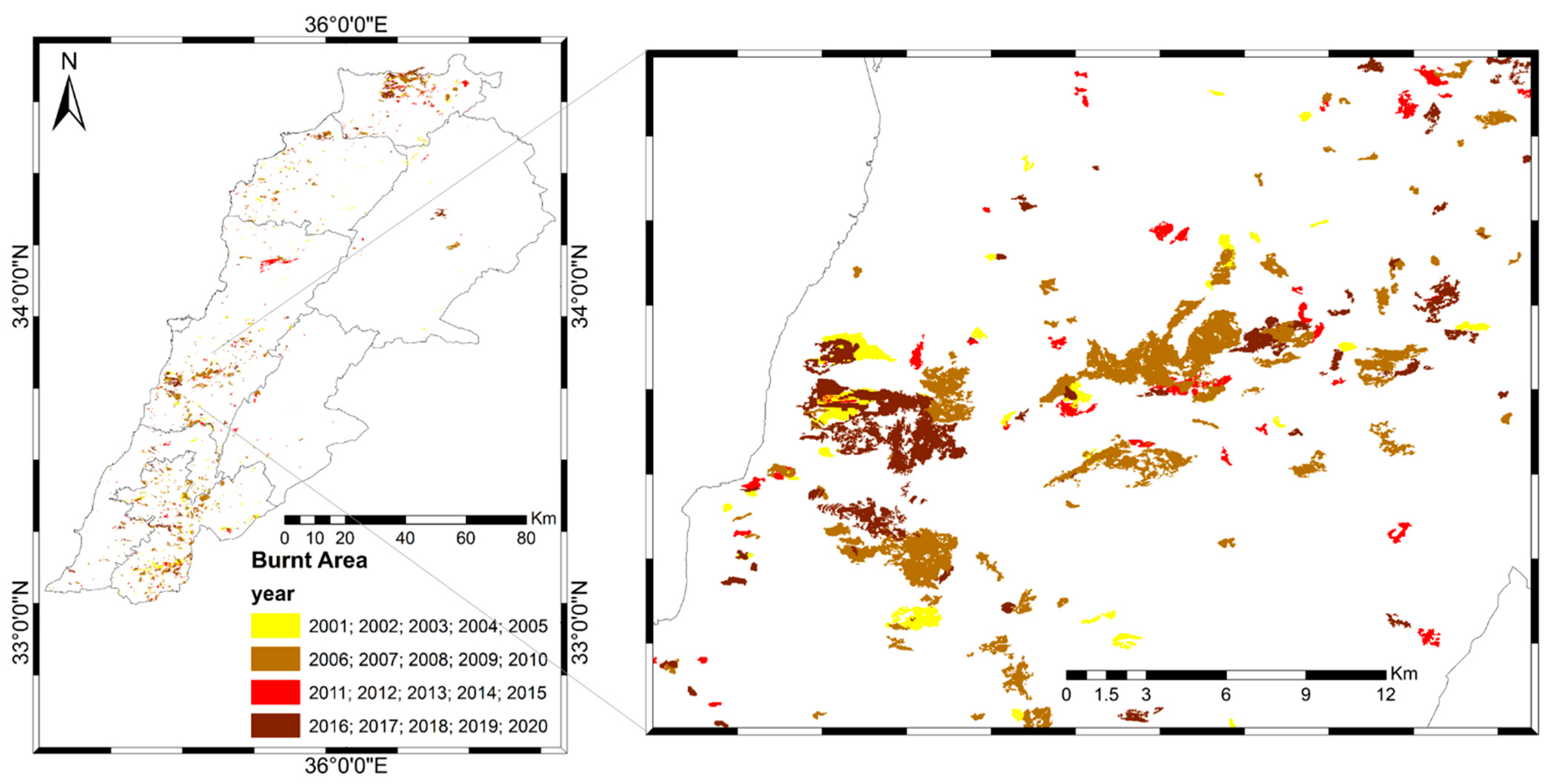
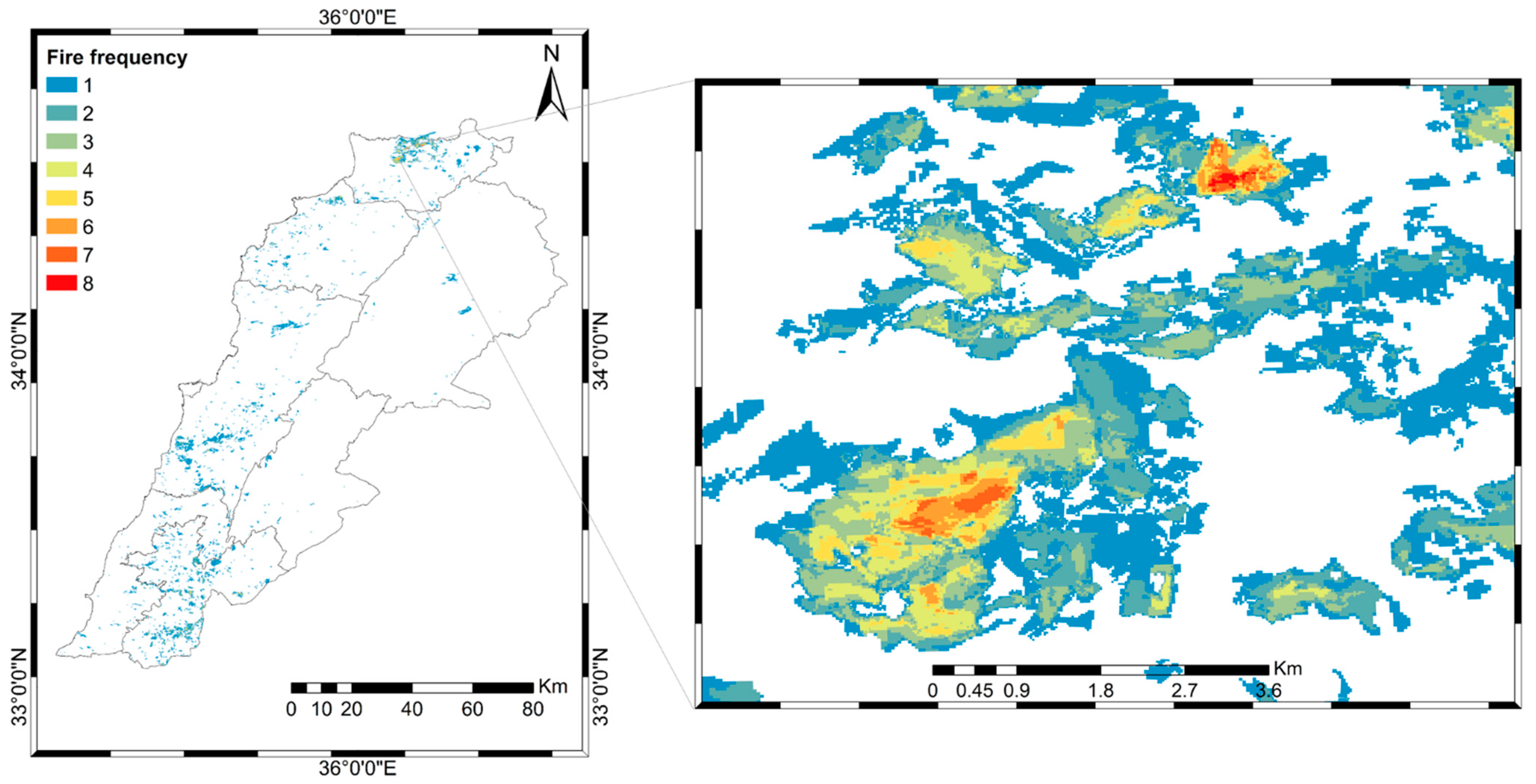
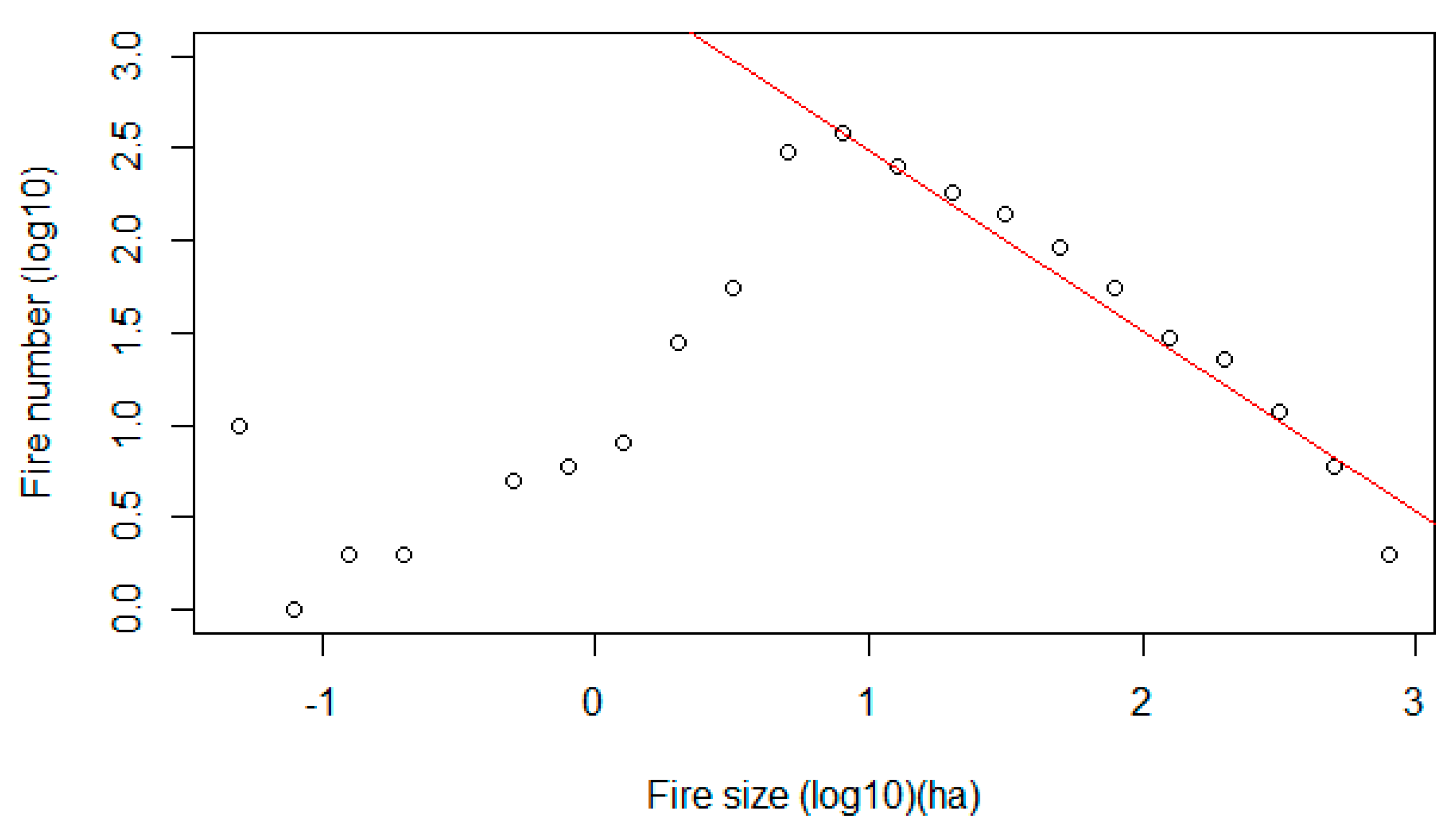




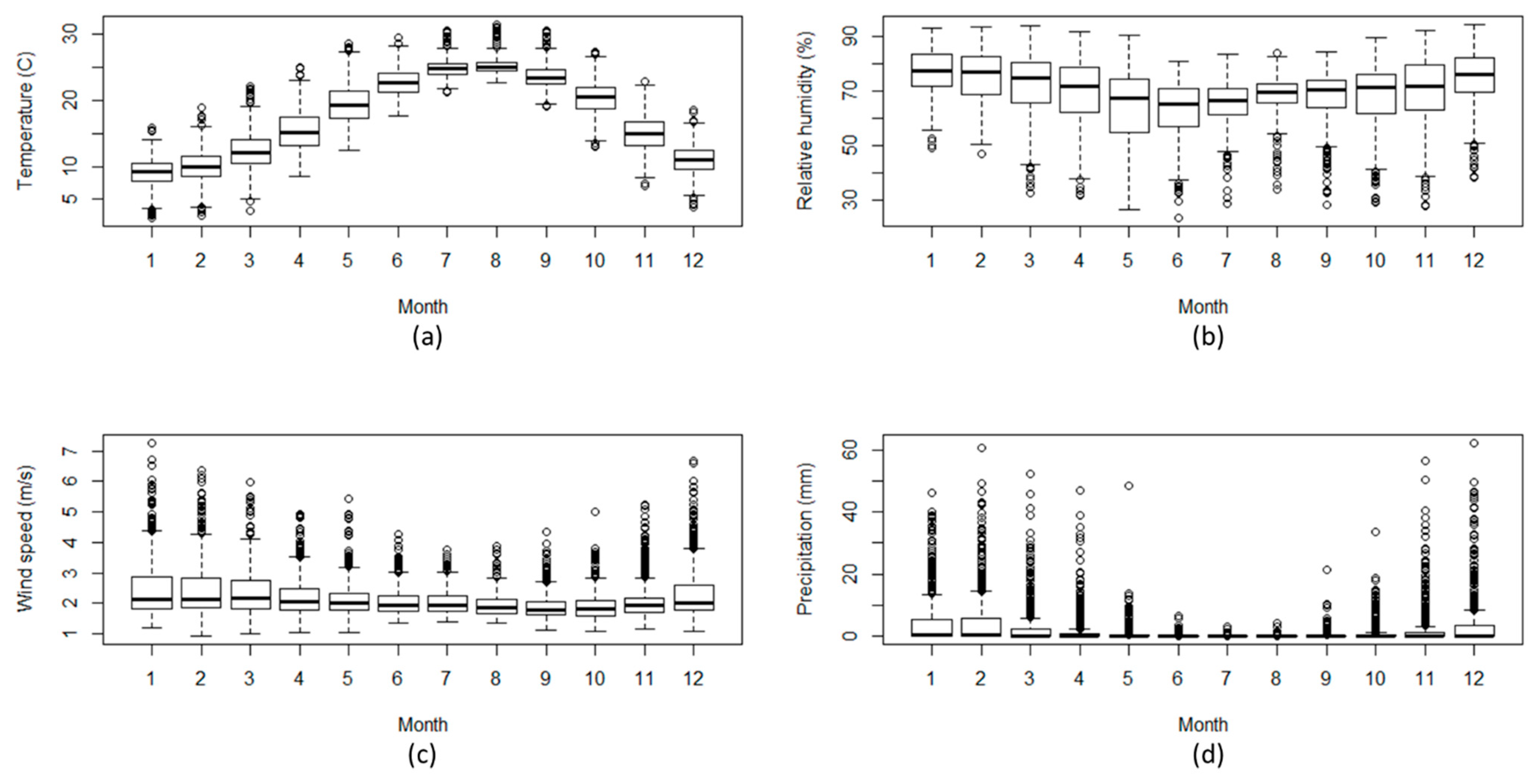
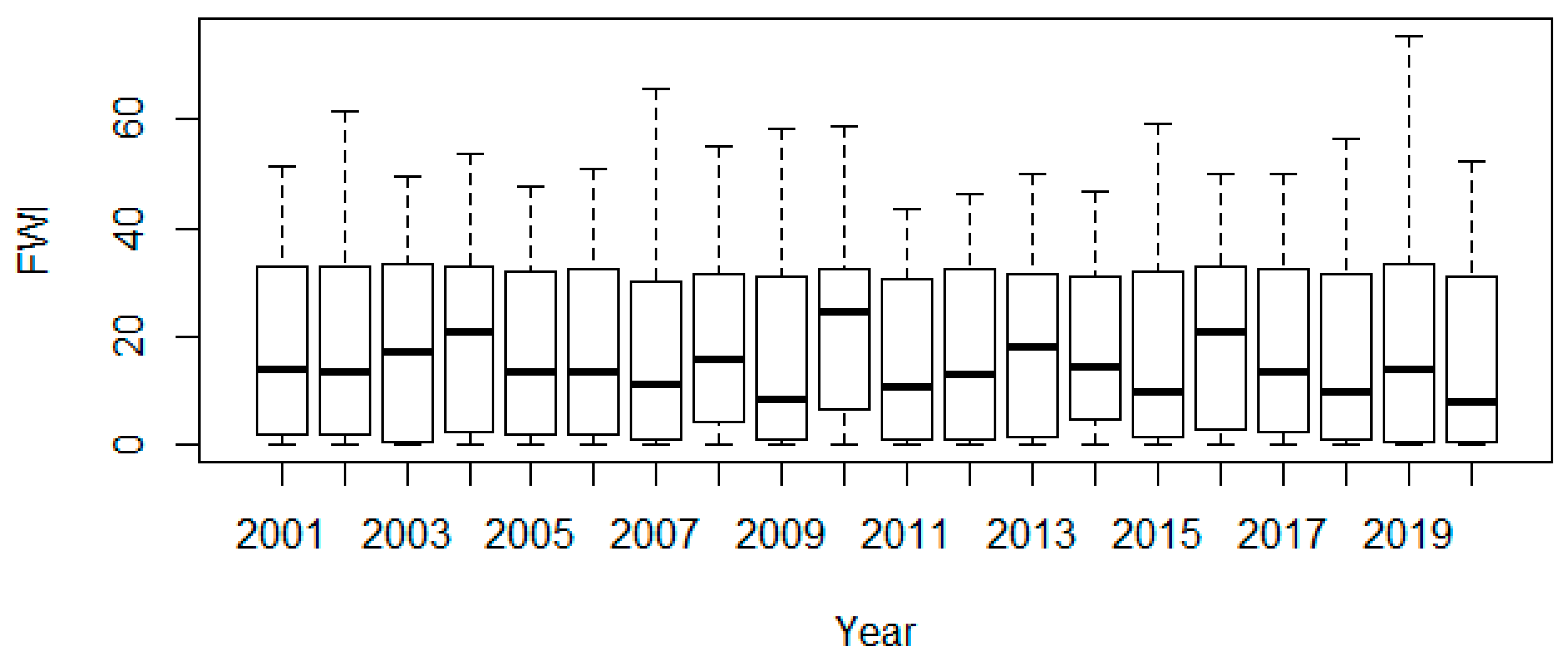
| Akkar | Baalbek-Hermel | Beqaa | Mount-Lebanon | Nabatiyeh | North | South | |
|---|---|---|---|---|---|---|---|
| Total Area (103 ha) | 79.0 | 285.3 | 141.3 | 197.3 | 110.0 | 118.7 | 92.4 |
| Forests and Shrubs (103 ha) | 27.2 | 71.5 | 28.3 | 80.1 | 29.3 | 40.2 | 28.8 |
| % of Forests and shrubs | 34.4 | 25.0 | 20.0 | 40.6 | 26.6 | 33.9 | 31.1 |
| Grass (103 ha) | 2.9 | 2.7 | 6.2 | 9.4 | 11.4 | 3.5 | 6.1 |
| % of Grass | 3.6 | 0.9 | 4.3 | 4.7 | 10.3 | 2.9 | 6.6 |
| Akkar | Baalbek-Hermel | Beqaa | Mount-Lebanon | Nabatiyeh | North | South | Total | |
|---|---|---|---|---|---|---|---|---|
| BA (103 ha) | 10.5 | 1.21 | 0.72 | 9.46 | 13.1 | 3.39 | 2.45 | 40.9 |
| % of BA | 25.8 | 2.9 | 1.8 | 23.1 | 32.1 | 8.3 | 6 | 100 |
| % wildland burnt.year−1 | 1.75 | 0.08 | 0.1 | 0.52 | 1.61 | 0.38 | 0.35 | 0.58 |
| % forests and shrubs burnt.year−1 | 0.82 | 0.04 | 0.07 | 0.5 | 1.12 | 0.31 | 0.25 | 0.39 |
| % grass burnt.year−1 | 10.67 | 0.92 | 0.22 | 0.75 | 2.86 | 1.19 | 0.8 | 1.97 |
| Dataset | 2001 | 2002 | 2003 | 2004 | 2005 | 2006 | 2007 | 2008 | 2009 | 2010 |
| This study (all fires) | 96 | 146 | 71 | 64 | 11 | 64 | 206 | 39 | 60 | 130 |
| This study (fires ≥ 5 ha) | 94 | 143 | 59 | 60 | 10 | 61 | 204 | 38 | 59 | 125 |
| UOB/MoE | NA | NA | NA | NA | NA | NA | NA | 179 | 157 | 295 |
| National fire inventory | 393 | 2654 | 2075 | 569 | 675 | 666 | 675 | 507 | 370 | 578 |
| Dataset | 2011 | 2012 | 2013 | 2014 | 2015 | 2016 | 2017 | 2018 | 2019 | 2020 |
| This study (all fires) | 54 | 31 | 114 | 44 | 59 | 114 | 31 | 68 | 115 | 68 |
| This study (fires ≥ 5 ha) | 52 | 22 | 106 | 41 | 51 | 103 | 22 | 42 | 98 | 51 |
| UOB/MoE | 53 | 95 | 50 | 152 | 85 | 199 | 79 | 8 | 55 | NA |
| National fire inventory | 355 | 429 | 466 | NA | NA | NA | NA | NA | NA | NA |
| Dataset | 2001 | 2002 | 2003 | 2004 | 2005 | 2006 | 2007 | 2008 | 2009 | 2010 |
| This study | 1.65 | 3.30 | 1.49 | 1.13 | 0.25 | 4.30 | 5.76 | 1.15 | 1.34 | 4.29 |
| ESA FireCC51 | 0 | 1.08 | 0.91 | 1.24 | 0.21 | 7.40 | 4.70 | 0.11 | 1.67 | 3.57 |
| UOB/MoE | NA | NA | NA | NA | NA | NA | NA | 0.83 | 0.77 | 4.31 |
| MCD64A1 | 0 | 0 | 0 | 0.24 | 0 | 1.12 | 1.15 | 0 | 0 | 0.59 |
| Dataset | 2011 | 2012 | 2013 | 2014 | 2015 | 2016 | 2017 | 2018 | 2019 | 2020 |
| This study | 1.19 | 1.09 | 2.46 | 0.71 | 1.22 | 1.94 | 0.42 | 0.67 | 3.01 | 3.52 |
| ESA FireCC51 | 0.13 | 0.88 | 0.85 | 0.23 | 0.51 | 1.50 | 0.24 | 0.43 | 1.04 | NA |
| UOB/MoE | 0.25 | 0.84 | 0.15 | 1.81 | 0.60 | 1.43 | 0.23 | 0.13 | 0.90 | NA |
| MCD64A1 | 0 | 0.10 | 0.31 | 0 | 0.14 | 0 | 0.12 | 0 | 1.17 | NA |
| Fire Season | Monthly BA (ha) | ±SD (ha) | Monthly NBF | ±SD |
|---|---|---|---|---|
| June | 38.1 | 74.2 | 5.3 | 8.3 |
| July | 61 | 105.7 | 5.5 | 5.3 |
| August | 30.2 | 46.7 | 4.7 | 4.6 |
| September | 36.3 | 64.5 | 5.6 | 5.4 |
| October | 57.4 | 106 | 4.7 | 5.9 |
| November | 64.3 | 125.2 | 1.2 | 2.3 |
Publisher’s Note: MDPI stays neutral with regard to jurisdictional claims in published maps and institutional affiliations. |
© 2022 by the authors. Licensee MDPI, Basel, Switzerland. This article is an open access article distributed under the terms and conditions of the Creative Commons Attribution (CC BY) license (https://creativecommons.org/licenses/by/4.0/).
Share and Cite
Majdalani, G.; Koutsias, N.; Faour, G.; Adjizian-Gerard, J.; Mouillot, F. Fire Regime Analysis in Lebanon (2001–2020): Combining Remote Sensing Data in a Scarcely Documented Area. Fire 2022, 5, 141. https://doi.org/10.3390/fire5050141
Majdalani G, Koutsias N, Faour G, Adjizian-Gerard J, Mouillot F. Fire Regime Analysis in Lebanon (2001–2020): Combining Remote Sensing Data in a Scarcely Documented Area. Fire. 2022; 5(5):141. https://doi.org/10.3390/fire5050141
Chicago/Turabian StyleMajdalani, Georgia, Nikos Koutsias, Ghaleb Faour, Jocelyne Adjizian-Gerard, and Florent Mouillot. 2022. "Fire Regime Analysis in Lebanon (2001–2020): Combining Remote Sensing Data in a Scarcely Documented Area" Fire 5, no. 5: 141. https://doi.org/10.3390/fire5050141
APA StyleMajdalani, G., Koutsias, N., Faour, G., Adjizian-Gerard, J., & Mouillot, F. (2022). Fire Regime Analysis in Lebanon (2001–2020): Combining Remote Sensing Data in a Scarcely Documented Area. Fire, 5(5), 141. https://doi.org/10.3390/fire5050141







